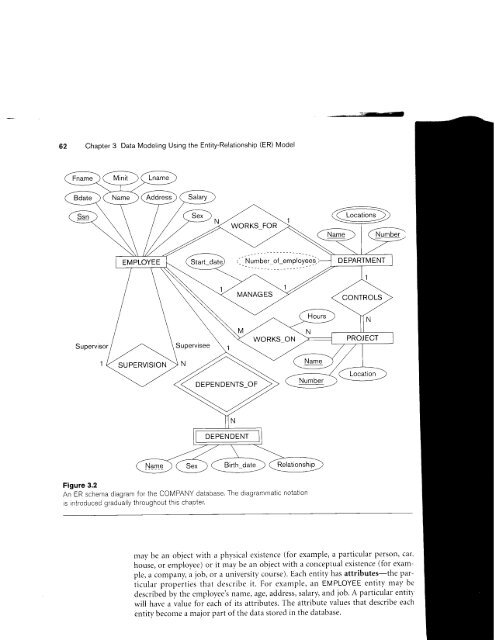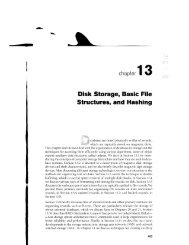Chapter 3 Data Modeling Using the Entity-Relationship (ER) Model Supervisor Supervisee DEPENDENTS_OF DEPENDENT Figure 3.2 An ER schema diagram for the coMPANY database. The diagrammatic notation is introduced gradually throughout <strong>this</strong> chapter. may be an object with a physical existence (for example, a particular person, car, house, or ernployee) or it rlay be an object with a conceptual existence (for example, a company, a job, or a university course). Each entity has attributes-the pariicular properties that describe it. For example, an EMPLOYEE entity may be described by the employee's name, age, address, salary, and job. A particular entitl' wili have a value for each of its attributes. The attribute values that describe each entity become a major part of the data stored in the database. :=ili€
't ---,--:-.: JmoeI -_==-?' T :5o11, car, or exam- -tlrc rrrr- nray be l.rr entity ribc each "d. 3.3 Entity Types, Entity Sets, Attributes, and Keys Figure 3.3 shows two entities and the values of their attributes. The EMPLOYEE r'ntity el has four attributes: Name, Address, Age, and Home_phone; their values are 'lohn Smith,''231I Kirby,''Houston, Texas 77001,''55,' and '713-749-2630,' respectively. The COMPANY entity c, has three attributes: Name, Headquarters, and Dresident; their values are'Sunco Oil,"Houston,'and'John Smith,'respectively. Several types of attributes occur in the ER model: simple versus composite, single- ',dued versus multivalued, and stored versus derived. First we define these attribute tvpes and illustrate their use via examples. Then we introduce the concept of a N U LL ', alue for an attribute. Composite versus Simple (Atomic) Attributes. Composite attributes can be Jivided into smaller subparts, which represent more basic attributes with independent meanings. For example, the Address attribute of the EMPLOYEE entity shown in Figure 3.3 can be subdivided into Street_address, City, State, and Zip,3 with the values '2311 Kirbyl 'Houston', 'Texas', and'77001.'Attributes that are not divisible are called simple or atomic attributes. Composite attributes can form a hierarchy; for crample, Street_address can be subdivided into three simple attributes: Number, Street, and Apartment_number, as shown in Figure 3.4. The value of a composite .rttribute is the concatenation of the values of its constituent simple attributes. Composite attributes are useful to model situations in which a user sometimes refers to the composite attribute as a unit but at other times refers specifically to its components. If the composite attribute is referenced only as a whole, there is no need to subdivide it into component attributes. For example, if there is no need to refer to the individual components of an address (ZIP Code, street, and so on), then the whole address can be designated as a simple attribute. Single-Valued versus Multivalued Attributes. Most attributes have a single r-alue for a particular entity; such attributes are called single-valued. For example, Age is a single-valued attribute of a person. In some cases an attribute can have a set Name: John Smith Address: 231 1 Kirby Houston, Texas 77001 Age:55 Home_phone : 7 1 3-749-2630 3. ZIP Code is the name used in the Un ted States for a f ve-dioit oostal code Name: Sunco Oil Headquarters : Houston President: John Smith trn,4Dt .\vtrtr 63 Figure 3.3 Two entities, ^ ^^; Llvll LV I LL Cl I al lU COMPANY c,, and their attributes,
- Page 1 and 2: .-" clrapter 3 Data Modeling Using
- Page 3 and 4: luy the 'ilSe ER '{L) r-Se 'il re )
- Page 5: t diaiional sually nrc of create ro
- Page 9 and 10: aJr. or a .lc vi.rlue, ()l hal\re a
- Page 11 and 12: .rre the ,.d into sofan .rsually it
- Page 13 and 14: )n cov- ,llue is r bcing rr.rlued t
- Page 15 and 16: pes. Jme oan rt of visor the The hi
- Page 17 and 18: ..itionship ..i..ler the 'utc calle
- Page 19 and 20: nbina- These _rs repployee s con- ,
- Page 21 and 22: lr. - ;ip'.-::.rl hh F* F | )r -ll
- Page 23 and 24: I ,' :i r€p- G. .'.iIlO[ ;i .::d
- Page 25 and 26: Ll,L2 rrilr 3.7.2 Proper Naming of
- Page 27 and 28: ., i:ed or ri :C\'€I3l TQ. and :;
- Page 29 and 30: }.!r :lJnY F.' : the ) '.)nle nl-':
- Page 31 and 32: '( .ipplied .:.tlrred, ' 'r each ,
- Page 33 and 34: lr .3 1C ,1,.r' x - =FERS ' . :tast
- Page 35: : t- Ft- I t T. &- F ,. t, p)' .tra














